Intercultural Business Communication: Reflection on Key Topics
VerifiedAdded on 2023/06/11
|8
|1875
|315
Journal and Reflective Writing
AI Summary
This assignment is a reflection journal focusing on social media and team communication within a business context. It explores the differences between traditional and new social media, highlighting the shift from one-to-many to many-to-many communication. The journal discusses various social media sites and tools, including Twitter and YouTube, and their potential for marketing and monetization. It also examines the pros and cons of social media in business, emphasizing the need for resources and adaptability. Furthermore, the reflection delves into team communication, exploring reasons for joining and leaving groups, stages of group development (forming, storming, norming, performing, adjourning), and the importance of effective communication for business growth. The journal concludes that embracing social media and fostering strong team communication can significantly benefit a business's communication strategies and market share.
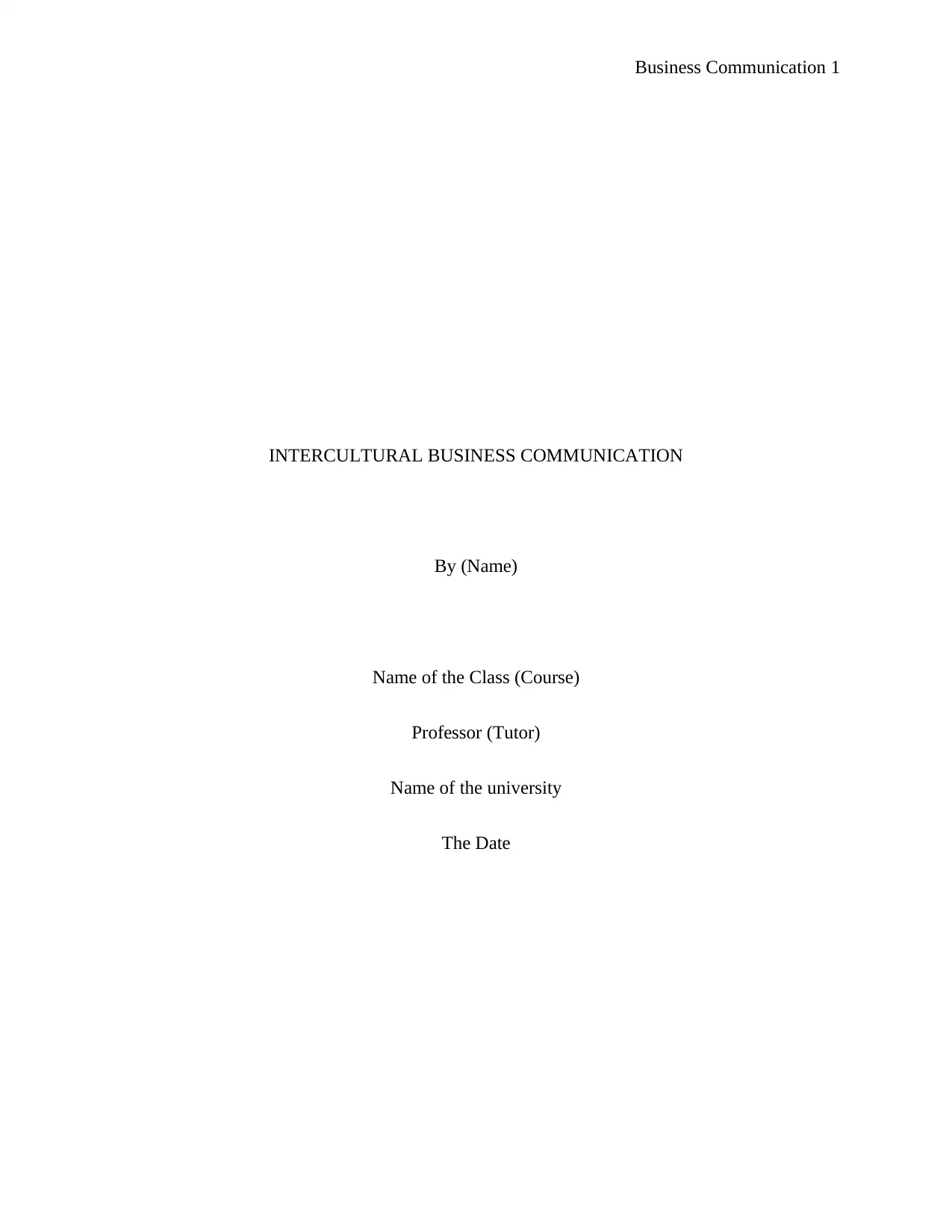
Business Communication 1
INTERCULTURAL BUSINESS COMMUNICATION
By (Name)
Name of the Class (Course)
Professor (Tutor)
Name of the university
The Date
INTERCULTURAL BUSINESS COMMUNICATION
By (Name)
Name of the Class (Course)
Professor (Tutor)
Name of the university
The Date
Paraphrase This Document
Need a fresh take? Get an instant paraphrase of this document with our AI Paraphraser
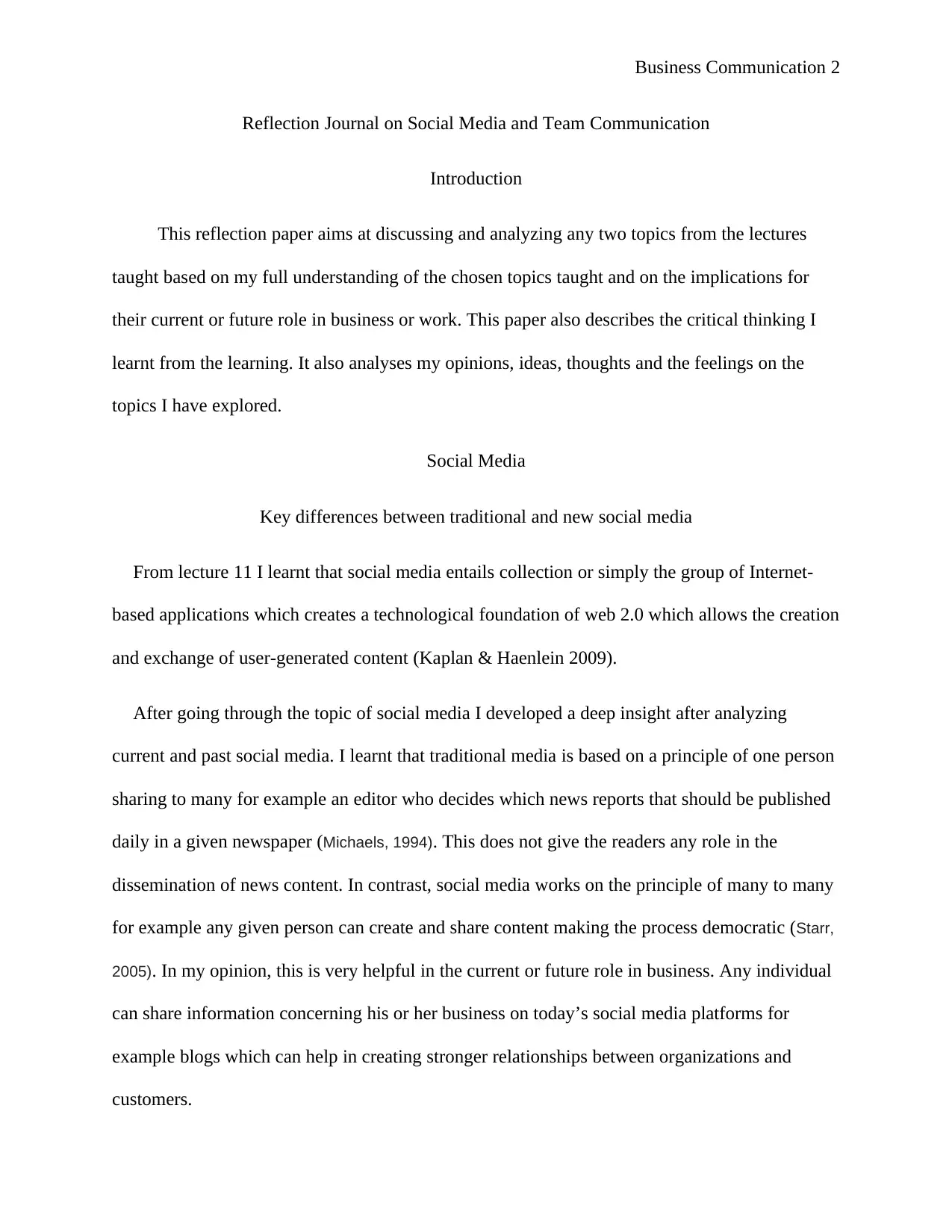
Business Communication 2
Reflection Journal on Social Media and Team Communication
Introduction
This reflection paper aims at discussing and analyzing any two topics from the lectures
taught based on my full understanding of the chosen topics taught and on the implications for
their current or future role in business or work. This paper also describes the critical thinking I
learnt from the learning. It also analyses my opinions, ideas, thoughts and the feelings on the
topics I have explored.
Social Media
Key differences between traditional and new social media
From lecture 11 I learnt that social media entails collection or simply the group of Internet-
based applications which creates a technological foundation of web 2.0 which allows the creation
and exchange of user-generated content (Kaplan & Haenlein 2009).
After going through the topic of social media I developed a deep insight after analyzing
current and past social media. I learnt that traditional media is based on a principle of one person
sharing to many for example an editor who decides which news reports that should be published
daily in a given newspaper (Michaels, 1994). This does not give the readers any role in the
dissemination of news content. In contrast, social media works on the principle of many to many
for example any given person can create and share content making the process democratic (Starr,
2005). In my opinion, this is very helpful in the current or future role in business. Any individual
can share information concerning his or her business on today’s social media platforms for
example blogs which can help in creating stronger relationships between organizations and
customers.
Reflection Journal on Social Media and Team Communication
Introduction
This reflection paper aims at discussing and analyzing any two topics from the lectures
taught based on my full understanding of the chosen topics taught and on the implications for
their current or future role in business or work. This paper also describes the critical thinking I
learnt from the learning. It also analyses my opinions, ideas, thoughts and the feelings on the
topics I have explored.
Social Media
Key differences between traditional and new social media
From lecture 11 I learnt that social media entails collection or simply the group of Internet-
based applications which creates a technological foundation of web 2.0 which allows the creation
and exchange of user-generated content (Kaplan & Haenlein 2009).
After going through the topic of social media I developed a deep insight after analyzing
current and past social media. I learnt that traditional media is based on a principle of one person
sharing to many for example an editor who decides which news reports that should be published
daily in a given newspaper (Michaels, 1994). This does not give the readers any role in the
dissemination of news content. In contrast, social media works on the principle of many to many
for example any given person can create and share content making the process democratic (Starr,
2005). In my opinion, this is very helpful in the current or future role in business. Any individual
can share information concerning his or her business on today’s social media platforms for
example blogs which can help in creating stronger relationships between organizations and
customers.
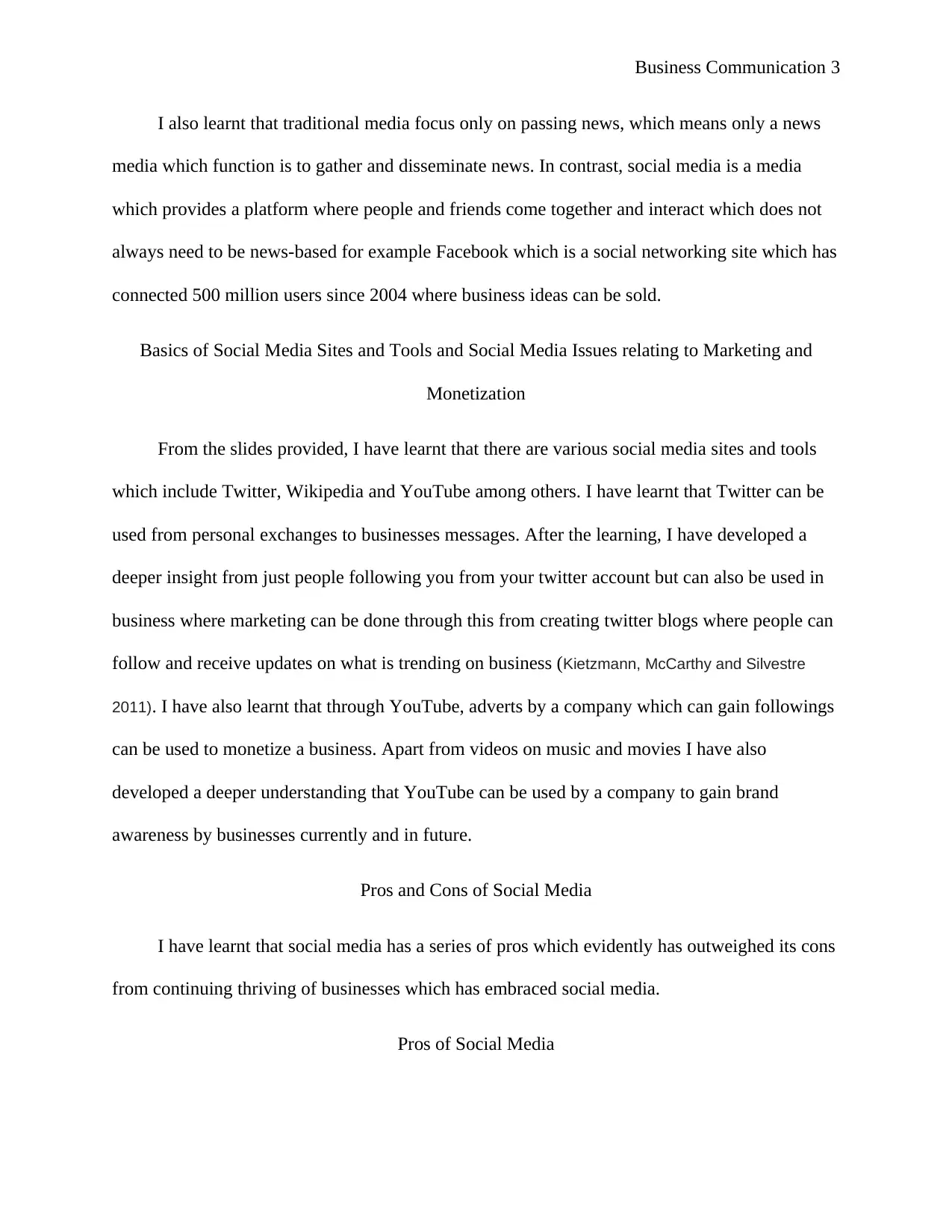
Business Communication 3
I also learnt that traditional media focus only on passing news, which means only a news
media which function is to gather and disseminate news. In contrast, social media is a media
which provides a platform where people and friends come together and interact which does not
always need to be news-based for example Facebook which is a social networking site which has
connected 500 million users since 2004 where business ideas can be sold.
Basics of Social Media Sites and Tools and Social Media Issues relating to Marketing and
Monetization
From the slides provided, I have learnt that there are various social media sites and tools
which include Twitter, Wikipedia and YouTube among others. I have learnt that Twitter can be
used from personal exchanges to businesses messages. After the learning, I have developed a
deeper insight from just people following you from your twitter account but can also be used in
business where marketing can be done through this from creating twitter blogs where people can
follow and receive updates on what is trending on business (Kietzmann, McCarthy and Silvestre
2011). I have also learnt that through YouTube, adverts by a company which can gain followings
can be used to monetize a business. Apart from videos on music and movies I have also
developed a deeper understanding that YouTube can be used by a company to gain brand
awareness by businesses currently and in future.
Pros and Cons of Social Media
I have learnt that social media has a series of pros which evidently has outweighed its cons
from continuing thriving of businesses which has embraced social media.
Pros of Social Media
I also learnt that traditional media focus only on passing news, which means only a news
media which function is to gather and disseminate news. In contrast, social media is a media
which provides a platform where people and friends come together and interact which does not
always need to be news-based for example Facebook which is a social networking site which has
connected 500 million users since 2004 where business ideas can be sold.
Basics of Social Media Sites and Tools and Social Media Issues relating to Marketing and
Monetization
From the slides provided, I have learnt that there are various social media sites and tools
which include Twitter, Wikipedia and YouTube among others. I have learnt that Twitter can be
used from personal exchanges to businesses messages. After the learning, I have developed a
deeper insight from just people following you from your twitter account but can also be used in
business where marketing can be done through this from creating twitter blogs where people can
follow and receive updates on what is trending on business (Kietzmann, McCarthy and Silvestre
2011). I have also learnt that through YouTube, adverts by a company which can gain followings
can be used to monetize a business. Apart from videos on music and movies I have also
developed a deeper understanding that YouTube can be used by a company to gain brand
awareness by businesses currently and in future.
Pros and Cons of Social Media
I have learnt that social media has a series of pros which evidently has outweighed its cons
from continuing thriving of businesses which has embraced social media.
Pros of Social Media
⊘ This is a preview!⊘
Do you want full access?
Subscribe today to unlock all pages.

Trusted by 1+ million students worldwide
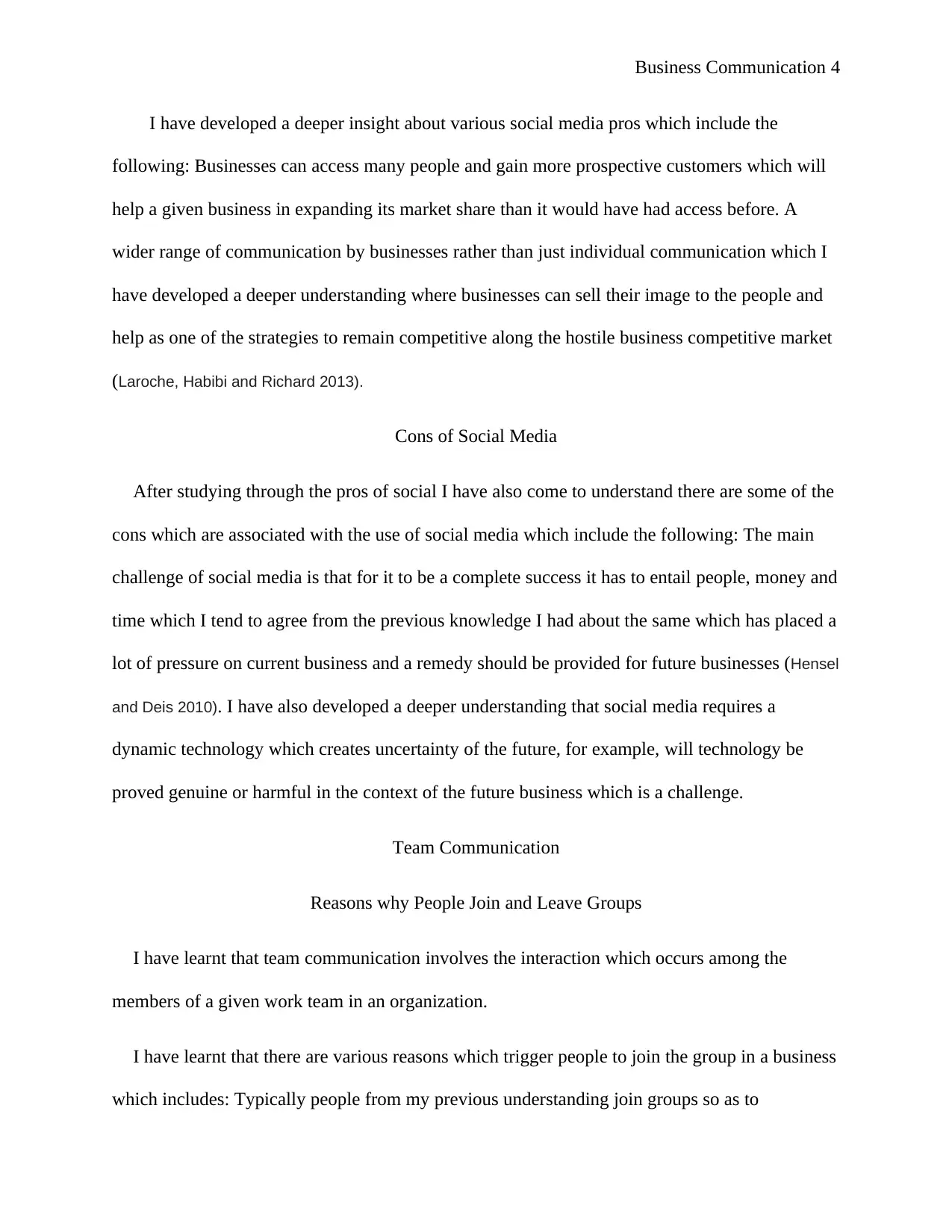
Business Communication 4
I have developed a deeper insight about various social media pros which include the
following: Businesses can access many people and gain more prospective customers which will
help a given business in expanding its market share than it would have had access before. A
wider range of communication by businesses rather than just individual communication which I
have developed a deeper understanding where businesses can sell their image to the people and
help as one of the strategies to remain competitive along the hostile business competitive market
(Laroche, Habibi and Richard 2013).
Cons of Social Media
After studying through the pros of social I have also come to understand there are some of the
cons which are associated with the use of social media which include the following: The main
challenge of social media is that for it to be a complete success it has to entail people, money and
time which I tend to agree from the previous knowledge I had about the same which has placed a
lot of pressure on current business and a remedy should be provided for future businesses (Hensel
and Deis 2010). I have also developed a deeper understanding that social media requires a
dynamic technology which creates uncertainty of the future, for example, will technology be
proved genuine or harmful in the context of the future business which is a challenge.
Team Communication
Reasons why People Join and Leave Groups
I have learnt that team communication involves the interaction which occurs among the
members of a given work team in an organization.
I have learnt that there are various reasons which trigger people to join the group in a business
which includes: Typically people from my previous understanding join groups so as to
I have developed a deeper insight about various social media pros which include the
following: Businesses can access many people and gain more prospective customers which will
help a given business in expanding its market share than it would have had access before. A
wider range of communication by businesses rather than just individual communication which I
have developed a deeper understanding where businesses can sell their image to the people and
help as one of the strategies to remain competitive along the hostile business competitive market
(Laroche, Habibi and Richard 2013).
Cons of Social Media
After studying through the pros of social I have also come to understand there are some of the
cons which are associated with the use of social media which include the following: The main
challenge of social media is that for it to be a complete success it has to entail people, money and
time which I tend to agree from the previous knowledge I had about the same which has placed a
lot of pressure on current business and a remedy should be provided for future businesses (Hensel
and Deis 2010). I have also developed a deeper understanding that social media requires a
dynamic technology which creates uncertainty of the future, for example, will technology be
proved genuine or harmful in the context of the future business which is a challenge.
Team Communication
Reasons why People Join and Leave Groups
I have learnt that team communication involves the interaction which occurs among the
members of a given work team in an organization.
I have learnt that there are various reasons which trigger people to join the group in a business
which includes: Typically people from my previous understanding join groups so as to
Paraphrase This Document
Need a fresh take? Get an instant paraphrase of this document with our AI Paraphraser
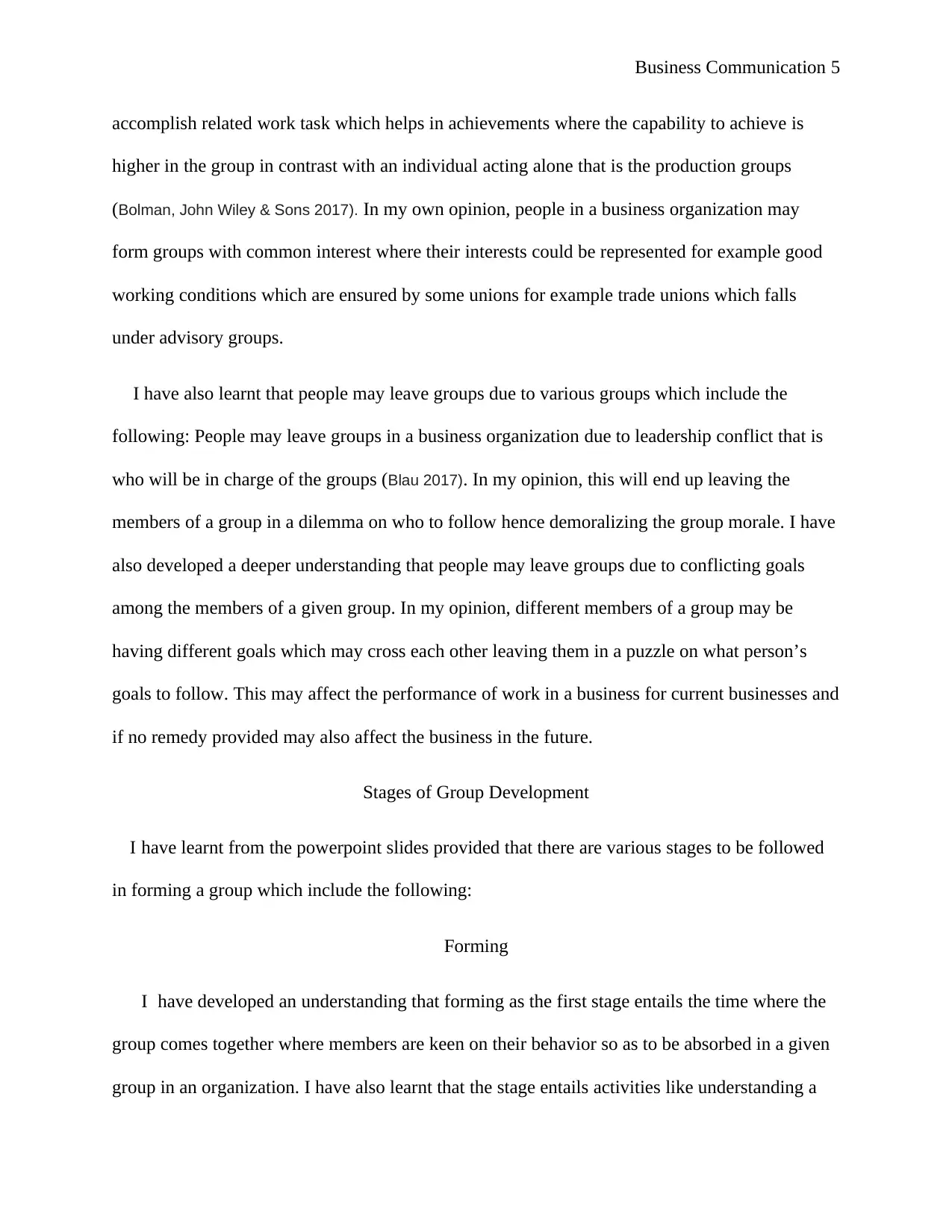
Business Communication 5
accomplish related work task which helps in achievements where the capability to achieve is
higher in the group in contrast with an individual acting alone that is the production groups
(Bolman, John Wiley & Sons 2017). In my own opinion, people in a business organization may
form groups with common interest where their interests could be represented for example good
working conditions which are ensured by some unions for example trade unions which falls
under advisory groups.
I have also learnt that people may leave groups due to various groups which include the
following: People may leave groups in a business organization due to leadership conflict that is
who will be in charge of the groups (Blau 2017). In my opinion, this will end up leaving the
members of a group in a dilemma on who to follow hence demoralizing the group morale. I have
also developed a deeper understanding that people may leave groups due to conflicting goals
among the members of a given group. In my opinion, different members of a group may be
having different goals which may cross each other leaving them in a puzzle on what person’s
goals to follow. This may affect the performance of work in a business for current businesses and
if no remedy provided may also affect the business in the future.
Stages of Group Development
I have learnt from the powerpoint slides provided that there are various stages to be followed
in forming a group which include the following:
Forming
I have developed an understanding that forming as the first stage entails the time where the
group comes together where members are keen on their behavior so as to be absorbed in a given
group in an organization. I have also learnt that the stage entails activities like understanding a
accomplish related work task which helps in achievements where the capability to achieve is
higher in the group in contrast with an individual acting alone that is the production groups
(Bolman, John Wiley & Sons 2017). In my own opinion, people in a business organization may
form groups with common interest where their interests could be represented for example good
working conditions which are ensured by some unions for example trade unions which falls
under advisory groups.
I have also learnt that people may leave groups due to various groups which include the
following: People may leave groups in a business organization due to leadership conflict that is
who will be in charge of the groups (Blau 2017). In my opinion, this will end up leaving the
members of a group in a dilemma on who to follow hence demoralizing the group morale. I have
also developed a deeper understanding that people may leave groups due to conflicting goals
among the members of a given group. In my opinion, different members of a group may be
having different goals which may cross each other leaving them in a puzzle on what person’s
goals to follow. This may affect the performance of work in a business for current businesses and
if no remedy provided may also affect the business in the future.
Stages of Group Development
I have learnt from the powerpoint slides provided that there are various stages to be followed
in forming a group which include the following:
Forming
I have developed an understanding that forming as the first stage entails the time where the
group comes together where members are keen on their behavior so as to be absorbed in a given
group in an organization. I have also learnt that the stage entails activities like understanding a
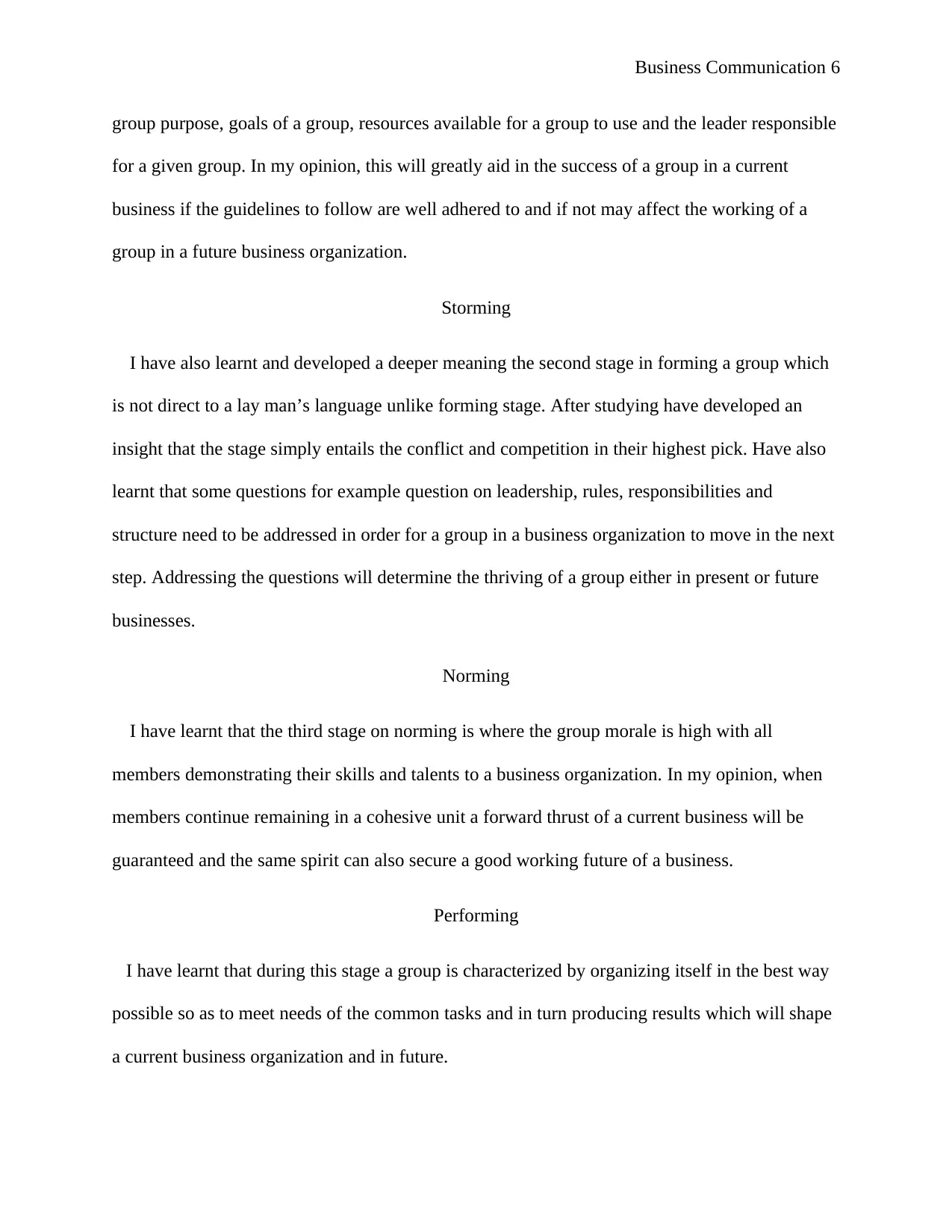
Business Communication 6
group purpose, goals of a group, resources available for a group to use and the leader responsible
for a given group. In my opinion, this will greatly aid in the success of a group in a current
business if the guidelines to follow are well adhered to and if not may affect the working of a
group in a future business organization.
Storming
I have also learnt and developed a deeper meaning the second stage in forming a group which
is not direct to a lay man’s language unlike forming stage. After studying have developed an
insight that the stage simply entails the conflict and competition in their highest pick. Have also
learnt that some questions for example question on leadership, rules, responsibilities and
structure need to be addressed in order for a group in a business organization to move in the next
step. Addressing the questions will determine the thriving of a group either in present or future
businesses.
Norming
I have learnt that the third stage on norming is where the group morale is high with all
members demonstrating their skills and talents to a business organization. In my opinion, when
members continue remaining in a cohesive unit a forward thrust of a current business will be
guaranteed and the same spirit can also secure a good working future of a business.
Performing
I have learnt that during this stage a group is characterized by organizing itself in the best way
possible so as to meet needs of the common tasks and in turn producing results which will shape
a current business organization and in future.
group purpose, goals of a group, resources available for a group to use and the leader responsible
for a given group. In my opinion, this will greatly aid in the success of a group in a current
business if the guidelines to follow are well adhered to and if not may affect the working of a
group in a future business organization.
Storming
I have also learnt and developed a deeper meaning the second stage in forming a group which
is not direct to a lay man’s language unlike forming stage. After studying have developed an
insight that the stage simply entails the conflict and competition in their highest pick. Have also
learnt that some questions for example question on leadership, rules, responsibilities and
structure need to be addressed in order for a group in a business organization to move in the next
step. Addressing the questions will determine the thriving of a group either in present or future
businesses.
Norming
I have learnt that the third stage on norming is where the group morale is high with all
members demonstrating their skills and talents to a business organization. In my opinion, when
members continue remaining in a cohesive unit a forward thrust of a current business will be
guaranteed and the same spirit can also secure a good working future of a business.
Performing
I have learnt that during this stage a group is characterized by organizing itself in the best way
possible so as to meet needs of the common tasks and in turn producing results which will shape
a current business organization and in future.
⊘ This is a preview!⊘
Do you want full access?
Subscribe today to unlock all pages.

Trusted by 1+ million students worldwide
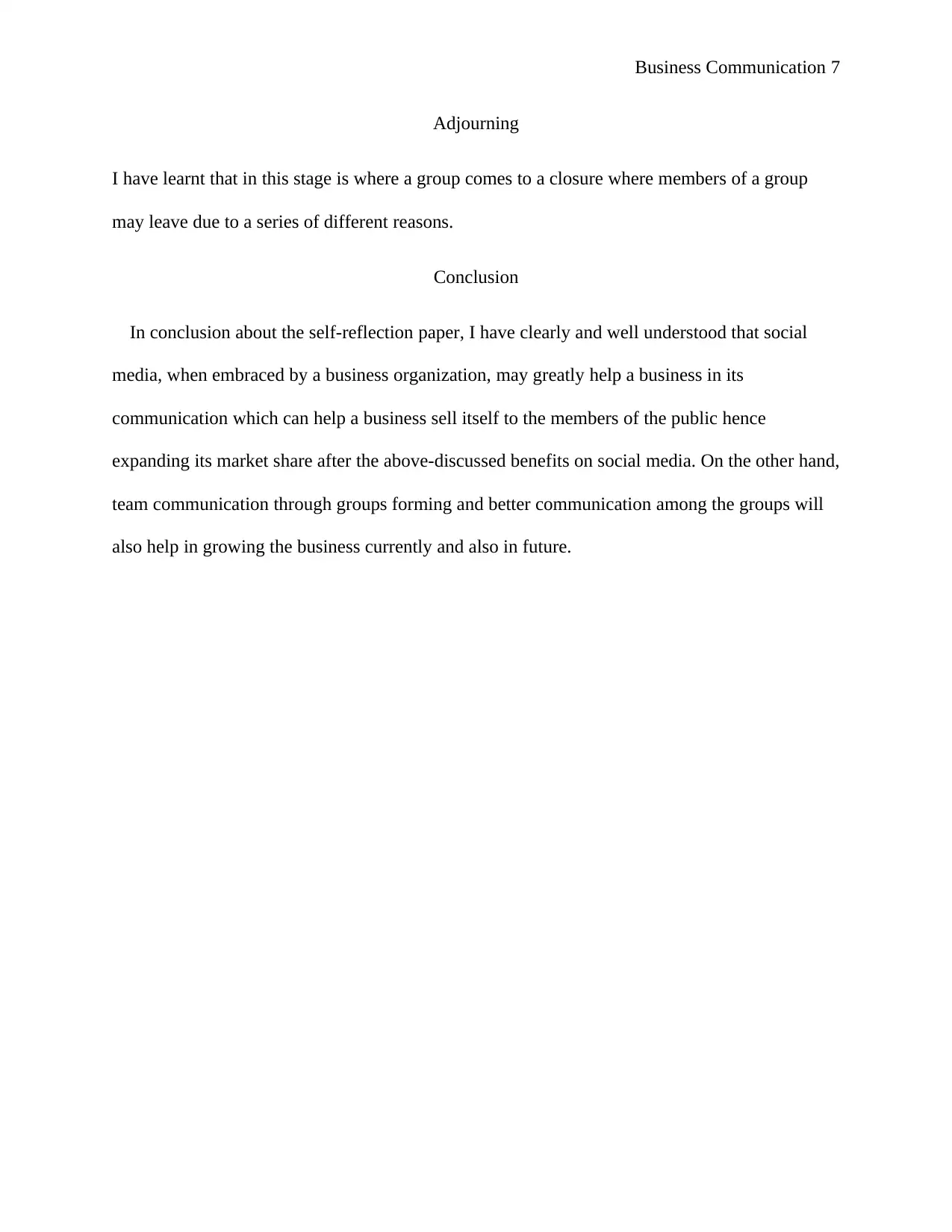
Business Communication 7
Adjourning
I have learnt that in this stage is where a group comes to a closure where members of a group
may leave due to a series of different reasons.
Conclusion
In conclusion about the self-reflection paper, I have clearly and well understood that social
media, when embraced by a business organization, may greatly help a business in its
communication which can help a business sell itself to the members of the public hence
expanding its market share after the above-discussed benefits on social media. On the other hand,
team communication through groups forming and better communication among the groups will
also help in growing the business currently and also in future.
Adjourning
I have learnt that in this stage is where a group comes to a closure where members of a group
may leave due to a series of different reasons.
Conclusion
In conclusion about the self-reflection paper, I have clearly and well understood that social
media, when embraced by a business organization, may greatly help a business in its
communication which can help a business sell itself to the members of the public hence
expanding its market share after the above-discussed benefits on social media. On the other hand,
team communication through groups forming and better communication among the groups will
also help in growing the business currently and also in future.
Paraphrase This Document
Need a fresh take? Get an instant paraphrase of this document with our AI Paraphraser
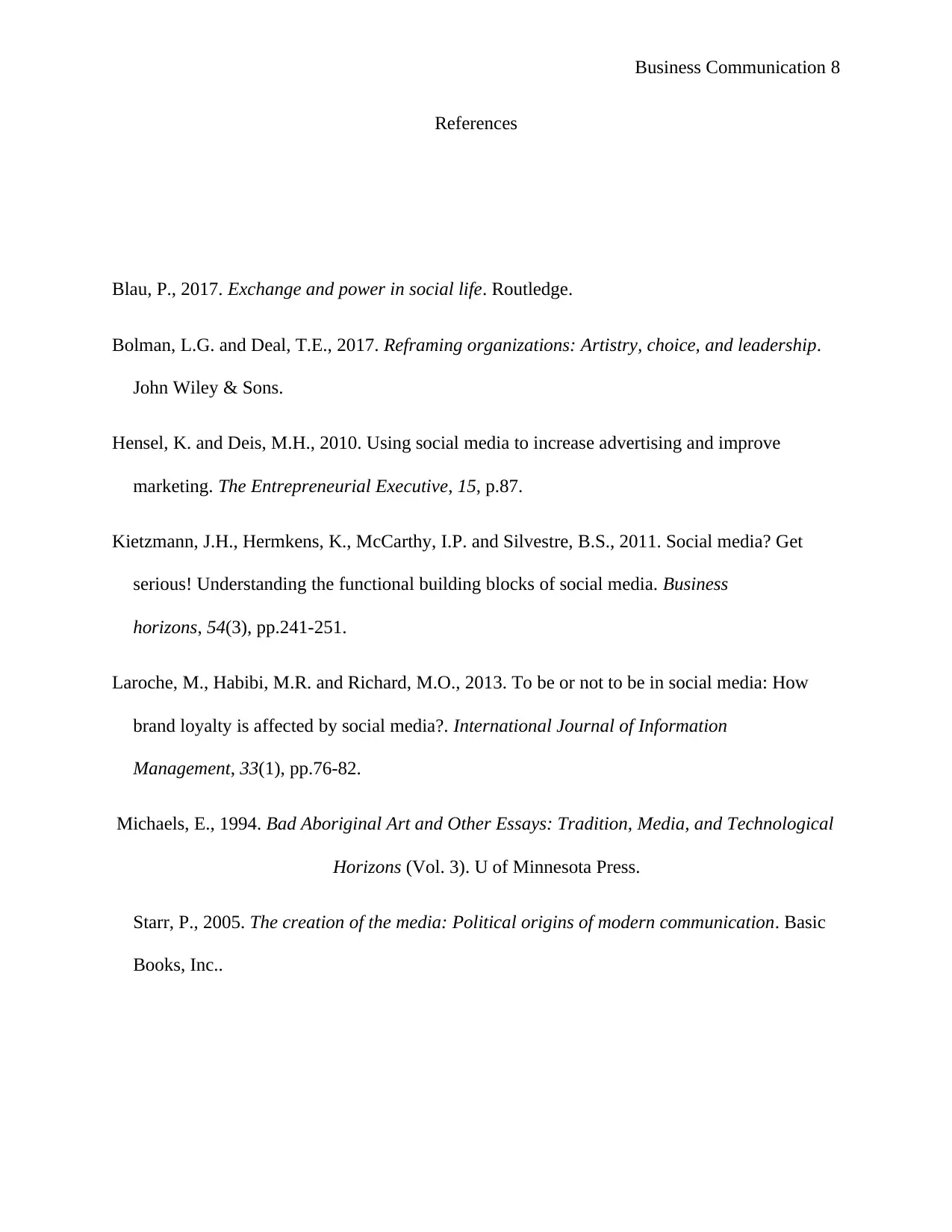
Business Communication 8
References
Blau, P., 2017. Exchange and power in social life. Routledge.
Bolman, L.G. and Deal, T.E., 2017. Reframing organizations: Artistry, choice, and leadership.
John Wiley & Sons.
Hensel, K. and Deis, M.H., 2010. Using social media to increase advertising and improve
marketing. The Entrepreneurial Executive, 15, p.87.
Kietzmann, J.H., Hermkens, K., McCarthy, I.P. and Silvestre, B.S., 2011. Social media? Get
serious! Understanding the functional building blocks of social media. Business
horizons, 54(3), pp.241-251.
Laroche, M., Habibi, M.R. and Richard, M.O., 2013. To be or not to be in social media: How
brand loyalty is affected by social media?. International Journal of Information
Management, 33(1), pp.76-82.
Michaels, E., 1994. Bad Aboriginal Art and Other Essays: Tradition, Media, and Technological
Horizons (Vol. 3). U of Minnesota Press.
Starr, P., 2005. The creation of the media: Political origins of modern communication. Basic
Books, Inc..
References
Blau, P., 2017. Exchange and power in social life. Routledge.
Bolman, L.G. and Deal, T.E., 2017. Reframing organizations: Artistry, choice, and leadership.
John Wiley & Sons.
Hensel, K. and Deis, M.H., 2010. Using social media to increase advertising and improve
marketing. The Entrepreneurial Executive, 15, p.87.
Kietzmann, J.H., Hermkens, K., McCarthy, I.P. and Silvestre, B.S., 2011. Social media? Get
serious! Understanding the functional building blocks of social media. Business
horizons, 54(3), pp.241-251.
Laroche, M., Habibi, M.R. and Richard, M.O., 2013. To be or not to be in social media: How
brand loyalty is affected by social media?. International Journal of Information
Management, 33(1), pp.76-82.
Michaels, E., 1994. Bad Aboriginal Art and Other Essays: Tradition, Media, and Technological
Horizons (Vol. 3). U of Minnesota Press.
Starr, P., 2005. The creation of the media: Political origins of modern communication. Basic
Books, Inc..
1 out of 8
Related Documents
Your All-in-One AI-Powered Toolkit for Academic Success.
+13062052269
info@desklib.com
Available 24*7 on WhatsApp / Email
![[object Object]](/_next/static/media/star-bottom.7253800d.svg)
Unlock your academic potential
Copyright © 2020–2025 A2Z Services. All Rights Reserved. Developed and managed by ZUCOL.





